About St. Dunstan and Gastonbury
Discover the amazing history of Glastonbury
St. Dunstan
The conference is dedicated to St. Dunstan and will actually be held on St. Dunstan's feast day in his honour. St. Dunstan was born in Somerset in 909 to Heorstan, an Anglo-Saxon noble. From a young age Dunstan received tuition from the Irish monks who lived in Glastonbury abbey. Dunstan showed a prodigious talent for all things spiritual. Before becoming a monk he was accused of sorcery and dark magic at a time when it was common for people to be in contact with both Christianity and Pagan practices. After being beaten and thrown into a cesspool by an angry mob, Dunstan fell gravely ill. Emerging from his sickness he decided to move into the church life, took robes and began living in Glastonbury as a monk.
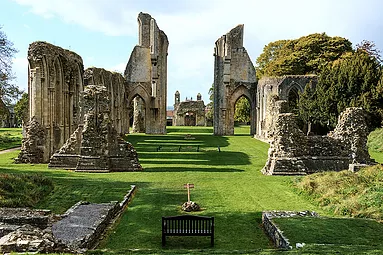
Glastonbury Abbey Today.
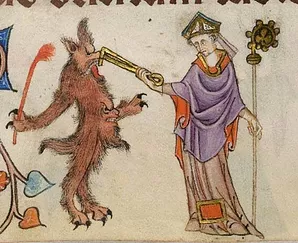
The wealth of Glastonbury abbey was twofold: the abbey was, at various times in history, one of the richest and most visited places of pilgrimmage in all of Europe. Yet Glastonbury abbey also housed one of the most extensive libraries of it's day and, it has been uncovered, alchemical equipment. So there was material wealth but also a great wealth of Spirit and learning. Depending on the sources, the most famous story around Dunstan goes that he was either working at his crucible or practising the harp, the devil showed up and disturbed him, making noise. Dunstan grabbed the devil by his nose with some hot tongs and made him promise not to bother him again. For this reason Dunstan is often depicted holding these tongs.
However Dunstan's association with alchemy runs much deeper because his name is attributed to alchemical texts in which he describes processes for a Philosopher's Stone and methods for making medicines from gemstones. Some historical documents speak of St. Dunstan diverting Glastonbury's white and red springs into the abbey for him to use in his alchemical experiments. Dunstan later became a trusted adviser to King Aethelstan of England who loved Dunstan so much he made him Archbishop of Canterbury. Dunstan was later canonized as a saint by the Catholic church.

Jump forward a few hundred years and the Renaissance man John Dee was baptised in his local church in London which was dedicated to none other than St. Dunstan himself. Later, as an adult, Dee would have his well known collaboration with the infamous Alchemist and Sorcerer, Edward Kelley. Sources differ on a few points - Elias Ashmole noted that Kelley and Dee found mysterious red and white powders in the ruins of Glastonbury Abbey along with a text written in a strange, unknown alphabet in the tomb of a bishop. Another source says that Kelley sought out Dee because of his sole discovery of the indecipherable book - Dee had a reputation as a polymath, a codebreaker and for his ability to read many languages.

Elias Ashmole, author of the cornerstone 1652 collection of British Alchemical texts Theatrum Chemicum Brittanium commented on a work he believed was attributed to St. Dunstan included four stones. A mineral stone, for transmuting metals, a vegetable stone for growing plants and animals and a magical stone, said to extend the life of people - this was the stone said to be possessed by Hermes. The fourth stone was said to be angelic, the same Stone that was possessed by Moses and was said to contain the secret of eternal life and made it possible to communicate with angels.
Whatever they did with their book and the powder, Dee and Kelley later showed up at the court of the famous patron of alchemy, Emperor Rudolf II where they would demonstrate the transumuting power of their work turning lead into gold, which was witnessed by the father of modern science, the alchemist Robert Boyle. St. Dunstan at this time became the patron Saint of Alchemists in Rudolf's court, and this is where history and the present converge and come full circle because the Alchemy Guild of course traces it's roots back to this very same Royal Court. Therefore St. Dunstan and his alchemy are coming back to Glastonbury, via Prague and the Guild. It may have taken a few hundred years, but here we are.
St. Dunstan is nowadays a patron saint of metalworkers. Actually St. Dunstan's day in England is still the official day that new gold is assayed. Dunstan is also the patron saint of musicians. We are also proud to dedicate this conference to him, in honour of him and for his contribution to alchemy.
About Glastonbury
A backdrop for a conference on alchemy and magic would be harder to find anywhere else in the world. Glastonbury is a town in rural Somerset, England that is abound with history, myth and significant events relating both to alchemy and magic. Indeed, the town itself is a living embodiment of the energies that often initiate change and spiritual transformation and pilgrims have attested for millennia to the synchronistic changes the town initiates within those who visit. Glastonbury is most famously equated with the legendary Avalon from Arthurian myths. The abbey actually claims to be the resting places for King Arthur himself. Glastonbury is often shrouded in mist and the 'mists of Avalon' frequently enshroud the Tor (Celtic for "hill")- the sacred place where King Arthur was said to be borne away in the legendary text by Sir Thomas Malory "Le Morte d'Arthur". Today St Michael's tower is what remains atop the peak of the Tor which rises dramatically out of the Somerset levels. The tower is actually a 14th century church built upon a much older church that for many centuries housed cells for meditation and prayer for an order of monks originally founded by early Irish holy men. The last abbot of Glastonbury, Abbot Whiting, was hanged atop the peak when King Henry VIII dissolved the Catholic Church in England, although some say what he was really after were the library and alchemical teachings, closely guarded treasures by the Abbey.
The Tor's history and its spiritual significance for the people of Britain of course goes back earlier than that. Before the Christian settlement, there were remains of a Roman Villa on top of the Tor. At the base of the Tor are two sacred springs said to be both healing and initiatory that have been used by pilgrims and spiritual seekers alike for probably 2000 years or more, well back into pre-Christian Celtic times. The springs are known locally as the "White Spring" and the "Red Spring", called so because the water flows red from the presence of iron. Legend says that Joseph of Arimathea came to Glastonbury not long after the death of Jesus and hid the Holy Grail in the Tor or the well itself. There was until recently a thorn tree on nearby Wearyall Hill where Joseph was said to have planted his staff into the ground and when he first landed, it grew into a tree. Interestingly, this thorn is a species not indigenous to England but to the Middle East.
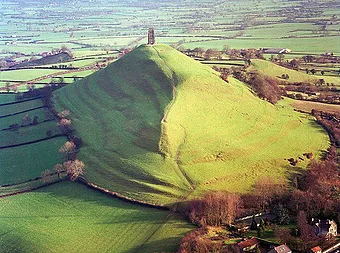

The Chalice Well
Today the Red Spring is known formally for this association with Joseph and Arthur as the "Chalice Well", and vistors come from all over the world every day to experience the deep peace that the well seems to emanate in this World Peace Garden.
The White Spring, by contrast, is built into the ground and is more of an underground cavern. Springs in Celtic mythology are usually seen as portals to the faerie realm and the underworld. The White Spring was dedicated in ancient times to the Goddess Brigid, keeper of the hearth and the flame. Others say that this is the home of Gwyn ap Nudd, King of the Faeries and ruler of the Underworld (Annwyn). There are altars and spaces dedicated to the magic of the Celtic world here.
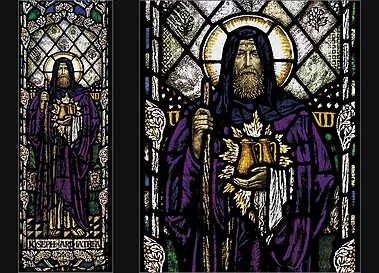
Stained Glass Window of St. Joseph in St. John's Church, Glastonbury.
Today, Glastonbury exists as a town of about 9000 people. It enjoys a fairly steady stream of visitors curious about the Tor, the Springs and the Abbey. For many people it is still a site of pilgrimage - if not for the desire to journey inward and sacred sites but for the endless cycle of workshops, talks, fabulous esoteric shops and the spiritual community that many call home. Glastonbury is also home to Library of Avalon, the largest public collection of esoteric books available in Europe.
Glastonbury has many festivals throughout the year and is home to a thriving community of people of all faiths who live and celebrate peacefully together. There are many beliefs about Glastonbury itself, one popular one is that it is the "Heart Chakra of the World". Indeed if you walk down the main street of Glastonbury just about anything can, and usually does synchronistically happen. Many people think that the town has an ability to keep on giving and giving to those who visit, this is for many the real world manifestation of the Grail.
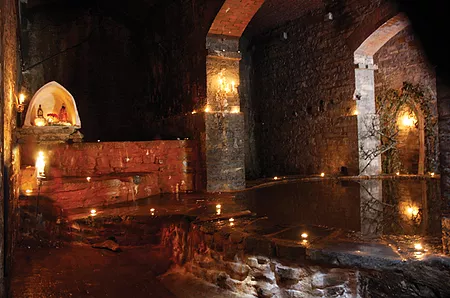

The White Spring, interior and exterior.

.webp)


